Mineralogical, Rock-Magnetic and Palaeomagnetic Properties of Metadolerites from Central Western Svalbard
Abstract
:1. Introduction
2. Geological Setting
3. Fieldwork and Methods
3.1. Fieldwork
3.2. Petrographic and Mineralogical Methods
3.3. Ferromagnetic Minerals Separation
3.4. Rock-Magnetic, Anisotropy of Magnetic Susceptibility (AMS) and Palaeomagnetic Methods
3.4.1. Rock-Magnetic Procedures
- Vibrating Sample Magnetometer (VSM)The hysteresis parameters including Mrs—saturation magnetization, Mr—saturation remanence, Hc—coercivity, Hcr—remanent coercivity, were determined using precise PMC MicroMag 2900 Series AGM Vibrating Sample Magnetometer (VSM) in maximum field 1 T. Hysteresis loops have been measured for the small particles of “whole rock” samples (up to 0.02 g) as well as the separated magnetic grains. All results were normalized against the mass of the samples.
- Temperature dependence of magnetic susceptibility (κ(T))The maximum unblocking temperatures (Tub max) were estimated from the temperature dependence of magnetic susceptibility κ (T measurements). The experiments were conducted on the MFKA1-FA Kappabridge using the high-temperature CS-3 furnace. Analyses were performed on “whole-rock” powder samples representing each of the palaeomagnetic sites. The κ(T) was monitored during continuous heating in air up to 700 °C and during cooling to room temperature.
- Three component IRM (isothermal remanent magnetization) acquisition curve experiment [41]These procedures produced more detailed information about the ferromagnetic composition. It was possible to observe the contribution of low, medium and high coercivity minerals in the magnetic signal and identify them on the basis of their maximum unblocking temperatures (Tub max). Initially 12 selected cylindrical samples (2 from each of the sites) were magnetized in steps along the z-axis reaching 3 T. To magnetize the samples a MMPM-10 pulse magnetizer was used. After each level of magnetization, the IRM was measured using the Superconducting Quantum Interface Device (SQUID DC, model 755, 2G Enterprise Inc., Sand City, CA, USA) and then plotted on the diagram. In the next step the samples were magnetized along the other perpendicular axis: along the y-axis in 0.4 T and along the x-axis in 0.12 T, respectively. After magnetization, the samples were gradually thermally demagnetized in the MMTD1 magnetic furnace and measured on the SQUID at every temperature step to determine the decrease of magnetic signal.
3.4.2. Palaeomagnetic Procedures
3.4.3. Statistical Procedures and Software
4. Results
4.1. Petrography of Investigated Metadolerites
4.2. Identification of Ferromagnetic Minerals
4.2.1. Mineralogical Methods
4.2.2. Rock-Magnetic Experiments
4.3. Palaeomagnetic Results
- (1)
- A low temperature component (index L) which demagnetized below 250 °C, was calculated using the “free line fit” method of Butler [46]. This was characterized by a steep inclination that was probably influenced by the present-day magnetic field.
- (2)
- A medium temperature component (index M) which demagnetized in the 250–350 °C range of temperatures and calculated using the “free line fit” or the “anchored line fit” methods of Butler [46], was potentially related to pyrrhotite and/or magnetite/maghemite grains of relatively low-Tub, that were identified during the petrological and rock-magnetic experiments.
- (3)
- A high temperature component (index H) which demagnetized above 350 °C and up to 500 °C (before disturbance of the NRM pattern). That component was also calculated using the “free line fit” or the “anchored line fit” methods [46] and is potentially related to magnetite and/or maghemite grains with higher a Tub spectra than was the case for the M component.
5. Discussion
6. Conclusions
- (1)
- The results of rock-magnetic and petrological analyses, including experiments on ferromagnetic separates, reveal a dominance of metamorphic pyrrhotite and Fe-oxides carriers in the metadolerites of SW OIIL and show complete remineralization and reorganization of their ferromagnetic fabric during Caledonian sensu lato metamorphism and younger tectono-thermal events.
- (2)
- Field data together with an analysis of satellite images (available from the NPI Kart over Svalbard) have highlighted the presence previously unreported deformational features such as large and small-scale folding and the presence of high strain (shear) zones in the Daudmannsdalen, Daudmannsøyra, Protectorbreen sites. All of these features have the potential to influence the orientation of the palaeomagnetic signal carriers.
- (3)
- The results of the palaeomagnetic investigations are as follows:
- In five of the six sites the low temperature components (Tub < 250 °C) are characterised by high inclinations (~70°–80°) and are related to Mesozoic–Cenozoic remagnetization, probably influenced by the recent magnetic field.
- In four of the six sites the middle-high temperature components (Tub > 250 °C) were scattered and thus rejected for further consideration. Only from two sites did the middle-high temperature directions qualify. Palaeopoles calculated for these two sites are shifted from combined reference Laurussia–Baltica–Laurentia APWP. At this stage of the study it is not possible to precisely define origin of observed inconsistency. Potentially the shift of the qualified DAU2MH+, DAU4MH+ VGPs from the reference path can be related to L. Mesozoic–Cenozoic listric faulting of the Caledonian basement, postulated in the area of OIIL by Michalski et al. [14]. Additional rotations could be generated by localised shearing and the cumulative effects of localised west-dipping families of small scale faults which were observed in the sampling area.
- (4)
- Finally, it is evident, that to better understand the relationships between the preservation of the palaeomagnetic record and the succession of deformation events recorded in the Caledonian basement of Western Svalbard, further studies are required.
Author Contributions
Funding
Acknowledgments
Conflicts of Interest
Appendix A. Anisotropy of Magnetic Susceptibility

References
- Harland, W.B.; Wright, N. Alternative hypothesis for the pre-Carboniferous evolution of Svalbard. Norsk Polarinst. Skr. 1979, 167, 89–117. [Google Scholar]
- Gee, D.G. Svalbard’s Caledonian terranes reviewed. Geol. Foeren. Stockholm Forh. 1986, 108, 284–286. [Google Scholar] [CrossRef]
- Gee, D.G.; Page, L.M. Caledonian Terrane Assembly on Svalbard: New Evidence from Ar/Ar Dating in Ny Friesland. Am. J. Sci. 1994, 294, 1166–1186. [Google Scholar] [CrossRef]
- Gee, D.G.; Tebenkov, A.M. Svalbard: A fragment of the Laurentian margin. In The Neoproterozoic Timanide Orogen of Eastern Baltica; Gee, D.G., Pease, V., Eds.; The Geological Society of London: London, UK, 2004; Volume 30, pp. 191–206. [Google Scholar]
- Kośmińska, K.; Majka, J.; Mazur, S.; Krumbholz, M.; Klonowska, I.; Manecki, M.; Czerny, J.; Dwornik, M. Blueschist facies metamorphism in Nordenskiöld Land of west-central Svalbard. Terra Nova 2014, 26, 377–386. [Google Scholar] [CrossRef]
- Mazur, S.; Czerny, J.; Majka, J.; Manecki, M.; Holm, D.K.; Smyrak, A.; Wypych, A. A strike-slip terrane boundary in Wedel Jarlsberg Land, Svalbard, and its bearing on correlations of SW Spitsbergen with the Pearya terrane and Timanide belt. J. Geol. Soc. 2009, 166, 529–544. [Google Scholar] [CrossRef]
- Majka, J.; Kośmińska, K.; Mazur, S.; Czerny, J.; Piepjohn, K.; Dwornik, M.; Manecki, M. Two garnet growth events in polymetamorphic rocks in southwest Spitsbergen, Norway: Insight in the history of Neoproterozoic and early Paleozoic metamorphism in the High Arctic. Can. J. Earth Sci. 2015, 52, 1–17. [Google Scholar] [CrossRef]
- Majka, J. Kośmińska, K. Magmatic and metamorphic events recorded within the Southwestern Basement Province of Svalbard. Arktos 2017, 3, 5. [Google Scholar] [CrossRef]
- Piepjohn, K.; von Gosen, W.; Tessensohn, F.; Reinhardt, L.; McClelland, W.C.; Dallmann, W.K.; Gaedicke, C.; Harrison, J.C. Tectonic map of the Ellesmerian and Eurekan deformation belts on Svalbard, North Greenland, and the Queen Elizabeth Islands (Canadian Arctic). Arktos 2015, 1, 12. [Google Scholar] [CrossRef]
- Dallmann, W.K.; Elvevold, S.; Majka, J.; Piepjohn, K. Chapter 8: Tectonics and tectonothermal events. In Geoscience Atlas of Svalbard; Dallmann, W.K., Ed.; Norsk Polarinstitutt: Tromsø, Norway, 2015; Volume 148, pp. 175–220. [Google Scholar]
- Gasser, D.; Andresen, A. Caledonian terrane amalgamation of Svalbard: Detrital zircon provenance of Mesoproterozoic to Carboniferous strata from Oscar II Land, western Spitsbergen. Geol. Mag. 2013, 150, 1103–1126. [Google Scholar] [CrossRef]
- Michalski, K.; Lewandowski, M.; Manby, G.M. New palaeomagnetic, petrographic and 40Ar/39Ar data to test palaeogeographic reconstructions of Caledonide Svalbard. Geol. Mag. 2012, 149, 696–721. [Google Scholar] [CrossRef]
- Michalski, K.; Nejbert, K.; Domańska-Siuda, J.; Manby, G. New palaeomagnetic data from metamorphosed carbonates of Western Spitsbergen, Oscar II Land. Pol. Polar Res. 2014, 35, 553–592. [Google Scholar] [CrossRef]
- Michalski, K.; Manby, G.; Nejbert, K.; Domańska-Siuda, J.; Burzyński, M. Using palaeomagnetic and isotopic data to investigate late to post-Caledonian tectonothermal processes within the Western Terrane of Svalbard. J. Geol. Soc. Lond. 2017, 174, 572. [Google Scholar] [CrossRef]
- Burzyński, M.; Michalski, K.; Nejbert, K.; Domańska-Siuda, J.; Manby, G. High resolution mineralogical and rock magnetic study of ferromagnetic phases in metabasites from Oscar II Land, Western Spitsbergen—Towards reliable model linking mineralogical and palaeomagnetic data. Geophys. J. Int. 2017, 210, 390–405. [Google Scholar] [CrossRef]
- Trettin, H.P. Pearya: A composite terrane with Caledonian affinities in northern Ellesmere Island. Can. J. Earth Sci. 1987, 24, 224–245. [Google Scholar] [CrossRef]
- Piepjohn, K. The Svalbardian-Ellesmerian deformation of the Old Red Sandstone and the pore-Devonian basement in NW Spitsbergen (Svalbard). In New Perspectives on the Old Red Sandstone; Friend, P.F., Williams, B.P.J., Eds.; Special Publications; Geological Society of London: London, UK, 2000; Volume 180, pp. 585–601. [Google Scholar]
- Kośmińska, K.; Majka, J. A review of magmatic and metamorphic events recorded by crystalline basement of Southwestern Svalbard. In Proceedings of the 33rd Nordic Geological Winter Meeting, Denmark, Copenhagen, 10–12 January 2018. [Google Scholar]
- Majka, J.; Mazur, S.; Manecki, M.; Czerny, J.; Holm, D.K. Late Neoproterozoic amphibolite-facies etamorphism of a pre-Caledonian basement block in southwest Wedel Jarlsberg Land, Spitsbergen: New evidence from U–Th–Pb dating of monazite. Geol. Mag. 2008, 145, 822–830. [Google Scholar] [CrossRef]
- Majka, J.; Czerny, J.; Mazur, S.; Holm, D.K.; Manecki, M. Neoproterozoic metamorphic evolution of the Isbjørnhamna Group rocks from south-western Svalbard. Polar Res. 2010, 29, 250–264. [Google Scholar]
- Majka, J.; Be’eri-Shlevins, Y.; Gee, D.G.; Czerny, J.; Frei, D.; Ladenberger, A. Torellian (c. 640 Ma) metamorphic overprint of Tonian (c. 950 Ma) basement in the Caledonides of southwestern Svalbard. Geol. Mag. 2014, 151, 732–748. [Google Scholar] [CrossRef]
- Birkenmajer, K. Caledonides of Svalbard and plate tectonics. Bull. Geol. Soc. Den. 1975, 24, 1–19. [Google Scholar]
- Bjørnerud, M. Upper Proterozoic unconformity in northern Wedel-Jarlsberg Land, southwest Spitsbergen: Lithostratigrapby and tectonic implications. Polar Res. 1990, 8, 127–140. [Google Scholar] [CrossRef]
- Ohta, Y. Geochemistry of Precambrian basic igneous rocks between St Jonsfjorden and Isfjorden, central western Spitsbergen, Svalbard. Polar Res. 1985, 3, 49–67. [Google Scholar] [CrossRef]
- Czerny, J. Petrogenesis of Metavolcanites of the Southern Part of Wedel Jarlsberg Land (Spitsbergen); Wydawnictwo Oddziału PAN: Kraków, Poland, 1999; pp. 1–88. [Google Scholar]
- Harland, W.B. The Geology of Svalbard; Geological Society of London: London, UK, 1997; Volume 17, p. 521. [Google Scholar] [CrossRef]
- Dallmeyer, R.D.; Peucat, J.J.; Hirajima, T.; Ohta, Y. Tectonothermal chronology within a blueschist-eclogite complex, west-central Spitsbergen, Svalbard: Evidence from 40Ar/39Ar and Rb/Sr mineral ages. Lithos 1990, 24, 291–304. [Google Scholar] [CrossRef]
- Lyberis, N.; Manby, G.M. The origin of the West Spitsbergen Fold Belt from geological constraints and plate kinematics: Implications for the Arctic. Tectonophysics 1993, 224, 371–391. [Google Scholar] [CrossRef]
- Piepjohn, K.; von Gosen, W.; Tessensohn, F. The Eurekan deformation in the Arctic: An outline. J. Geol. Soc. 2016, 173, 1007. [Google Scholar] [CrossRef]
- Harland, W.B.; Horsfield, W.T.; Manby, G.M.; Morris, A.P. An outline pre-Carboniferous stratigraphy of West Spitsbergen. Norsk Polarinst. Skr. 1979, 167, 119–140. [Google Scholar]
- Bergh, S.G.; Ohta, Y.; Andresen, A.; Maher, H.D.; Braathen, A.; Dallmann, W.K. St. Jonsfjorden, Svalbard, 1:100,000; Theme Map No. 34; Norsk Polarinstitutt: Tromsø, Norway, 2003. [Google Scholar]
- Hjelle, A.; Ohta, Y.; Wisnes, T. Hecla Hoek rocks of Oscar II Land and Prins Karls Forland. Norsk Polarinst. Skr. 1979, 167, 145–170. [Google Scholar]
- Kanat, L.; Morris, A. A Working Hypothesis for Central Western Oscar II Land, Spitsbergen; Skrifter NR. 190; Norsk Polarinstitutt: Tromsø, Norway, 1988. [Google Scholar]
- Ohta, Y.; Hjelle, A.; Andresen, A.; Dallmann, W.K.; Salvigsen, O. Isfjorden, Svalbard 1:100,000; Theme Map No. 16; Norsk Polarinstitutt: Tromsø, Norway, 1992. [Google Scholar]
- Ohta, Y.; Hjelle, A.; Andresen, A.; Dallmann, W.K.; Sålvigsen, O. Geological Map of Svalbard, 1:100,000; Sheet B9G Isfjorden, with Description; Norsk Polarinstitutt: Tromsø, Norway, 1991; Temakart, 16. [Google Scholar]
- Maher, D.M., Jr.; Bergh, S.; Braathen, A.; Ohta, Y. Svartfjella, Eidembukta, and Daudmannsodden lineament: Tertiary orogen-parallel motion in the crystalline hinterland of Spitsbergen’s fold-thrust belt. Tectonics 1997, 16, 88–106. [Google Scholar] [CrossRef]
- Tessensohn, F.; Von Gosen, W.; Piepjohn, K. Permo-Carboniferous slivers infolded in the basement of Western Oscar II Land. Geol. Jahrbuch 2001, B91, 161–199. [Google Scholar]
- Hjelle, A.; Piepjohn, K.; Saalmann, K.; Ohta, Y.; Salvigsen, O.; Thieding, F.; Dallmann, W.K. Kongsfjorden, Svalbard, 1:100,000; Theme Map No. 30; Norsk Polarinstitutt: Tromsø, Norway, 1999. [Google Scholar]
- McAndrew, J. Calibration of a Frantz isodynamic separator and its application to mineral separation. Proc. Aust. Inst. Min. Met. 1957, 181, 59–73. [Google Scholar]
- Rosenblum, S.; Brownfield, I.K. Magnetic Susceptibilities of Minerals; US Geological Survey Open-File Report 99-529; US Department of the Interior: Washington, DC, USA, 2000. Available online: http://pubs.usgs.gov/of/1999/ofr-99-0529/ (accessed on 28 June 2018).
- Lowrie, W. Identification of ferromagnetic minerals in a rock by coercivity and unblocking temperature properties. Geophys. Res. Lett. 1990, 17, 159–162. [Google Scholar] [CrossRef]
- Chadima, M.; Jelinek, V. Anisoft 4.2. Anisotropy Data Browser. AGICO, 2009. Available online: http://www.agico.com/ (accessed on 28 June 2018).
- Chadima, M.; Hrouda, F. Remasoft 3.0 Paleomagnetic Data Browser and Analyzer. AGICO, 2009. Available online: http://www.agico.com/ (accessed on 28 June 2018).
- Kirschvink, J.L. The least-squares line and plane and the analysis of palaeomagnetic data. Geophys. J. Int. 1980, 62, 699–718. [Google Scholar] [CrossRef] [Green Version]
- Fisher, R. Dispersion on a sphere. Proc. R. Soc. Lond. Ser. A 1953, 217, 295–305. [Google Scholar] [CrossRef]
- Butler, R.F. Paleomagnetism: Magnetic Domains to Geological Terranes; Blackwell Scientific: Boston, MA, USA, 1992. [Google Scholar]
- Van der Voo, R. Paleomagnetism of the Atlantic, Tethys and Iapetus Oceans; Cambridge University Press: Cambridge, UK, 1993. [Google Scholar]
- Torsvik, T.H.; van der Voo, R.; Preeden, U.; Mac Niocaill, C.; Steinberger, B.; Doubrovine, P.V.; van Hinsbergen, D.J.J.; Domeier, M.; Gaina, C.; Tohver, E.; et al. Phanerozoic polar wander, paleogeography and dynamics. Earth-Sci. Rev. 2012, 114, 325–368. [Google Scholar] [CrossRef]
- Michalski, K. Palaeomagnetism of metacarbonates and fracture fills of Kongsfjorden islands (western Spitsbergen): Towards a better understanding of late- to post-Caledonian tectonic rotations. Pol. Polar Res. 2018, 39, 51–75. [Google Scholar] [CrossRef]
- Szlachta, K.; Michalski, K.; Brzózka, K.; Górka, B.; Gałązka-Friedman, J. Comparison of magnetic and Mössbauer results obtained for Palaeozoic rocks of Hornsund, Southern Spitsbergen, Arctic. Acta Phys. Pol. A 2008, 114, 1675–1682. [Google Scholar] [CrossRef]
- Frost, B.R. Magnetic petrology: Factors that control the occurrence of magnetite in crustal rocks. In Oxide Minerals: Petrologic and Magnetic Significance; Lindsley, D.H., Ed.; Mineralogical Society of America: Chantilly, VA, USA, 1991; Volume 25, pp. 489–509. [Google Scholar]
- Frost, B.R.; Lindsley, D.H. Occurrence of iron–titanium oxides in igneous rocks. In Oxide Minerals: Petrologic and Magnetic Significance; Lindsley, D.H., Ed.; Mineralogical Society of America: Chantilly, VA, USA, 1991; Volume 25, pp. 433–468. [Google Scholar]
- Haggerty, S.E. Opaque Mineral Oxides in Terrestrial Igneous Rocks; Mineralogical Society of America: Chantilly, VA, USA, 1976; Volume 3, pp. 101–300. [Google Scholar]
- Haggerty, S.E. Oxide textures—A mini-atlas. In Oxide Minerals: Petrologic and Magnetic Significance; Lindsley, D.H., Ed.; Mineralogical Society of America: Chantilly, VA, USA, 1991; Volume 25, pp. 129–219. [Google Scholar]
- Harlov, D.; Tropper, P.; Seifert, W.; Nijland, T.; Förster, H.J. Formation of Al-rich titanite (CaTiSiO4O–CaAlSiO4OH) reaction rims on ilmenite in metamorphic rocks as a function of fH2O and fO2. Lithos 2006, 88, 72–84. [Google Scholar] [CrossRef]
- Xirouchakis, D.; Lindsley, D.H. Equilibria among titanite, hedenbergite, fayalite, quartz, ilmenite and magnetite: Experiments and internally consistent thermodynamic data for titanite. Am. Mineral. 1998, 83, 712–725. [Google Scholar] [CrossRef]
- Hopkinson, J. Magnetic and other Physical Properties of Iron at a High Temperature. Philos. Trans. R. Soc. Lond. 1889, A180, 443–465. [Google Scholar] [CrossRef]
- Hrouda, F. A technique for the measurement of thermal changes of magnetic susceptibility of weakly magnetic rocks by the CS-2 apparatus and KLY-2 Kappabridge. Geophys. J. Int. 1994, 118, 604–612. [Google Scholar] [CrossRef] [Green Version]
- Li, Z.W.; Dobson, J.; Chen, Z.; Chang, W.J.; St. Pierre, T.G. Multimodal investigation of thermally induced changes in magnetic fabric and magnetic mineralogy. Geophys. J. Int. 2003, 135, 988–998. [Google Scholar] [CrossRef]
- Özdemir, Ö. Inversion of titanomaghemites. Phys. Earth Planet. Inter. 1987, 46, 184–196. [Google Scholar] [CrossRef]
- Matzka, J.; Krása, D. Oceanic basalt continuous thermal demagnetization curves. Geophys. J. Int. 2007, 169, 941–950. [Google Scholar] [CrossRef] [Green Version]
- Dekkers, M.J. Magnetic properties of natural pyrrhotite part 1: Behavior of initial susceptibility and saturation-magnetization related parameters in a grain-size dependent framework. Phys. Earth Planet. Inter. 1988, 52, 376–393. [Google Scholar] [CrossRef]
- Dunlop, D.J.; Özdemir, Ö. Rock Magnetism Fundamentals and Frontiers; Cambridge University Press: Cambridge, UK, 1997. [Google Scholar]
- Clark, S.A.; Glorstad-Clark, E.; Faleide, J.I.; Schmid, D.; Hartz, E.H.; Fjeldskaar, W. Southwest Barents Sea rift basin evolution: Comparing results from backstripping and time forward modelling. Basin Res. 2014, 26, 550–566. [Google Scholar] [CrossRef]
- Jelinek, V. Characterization of the magnetic fabrics of rocks. Tectonophysics 1981, 79, 63–67. [Google Scholar] [CrossRef]
- Oliva-Urcia, B.; Román-Berdiel, T.; Casas, A.M.; Pueyo, E.L.; Osácar, C. Tertiary compressional overprint on Aptian–Albian extensional magnetic fabrics, North-Pyrenean Zone. J. Struct. Geol. 2010, 32, 362–376. [Google Scholar] [CrossRef]

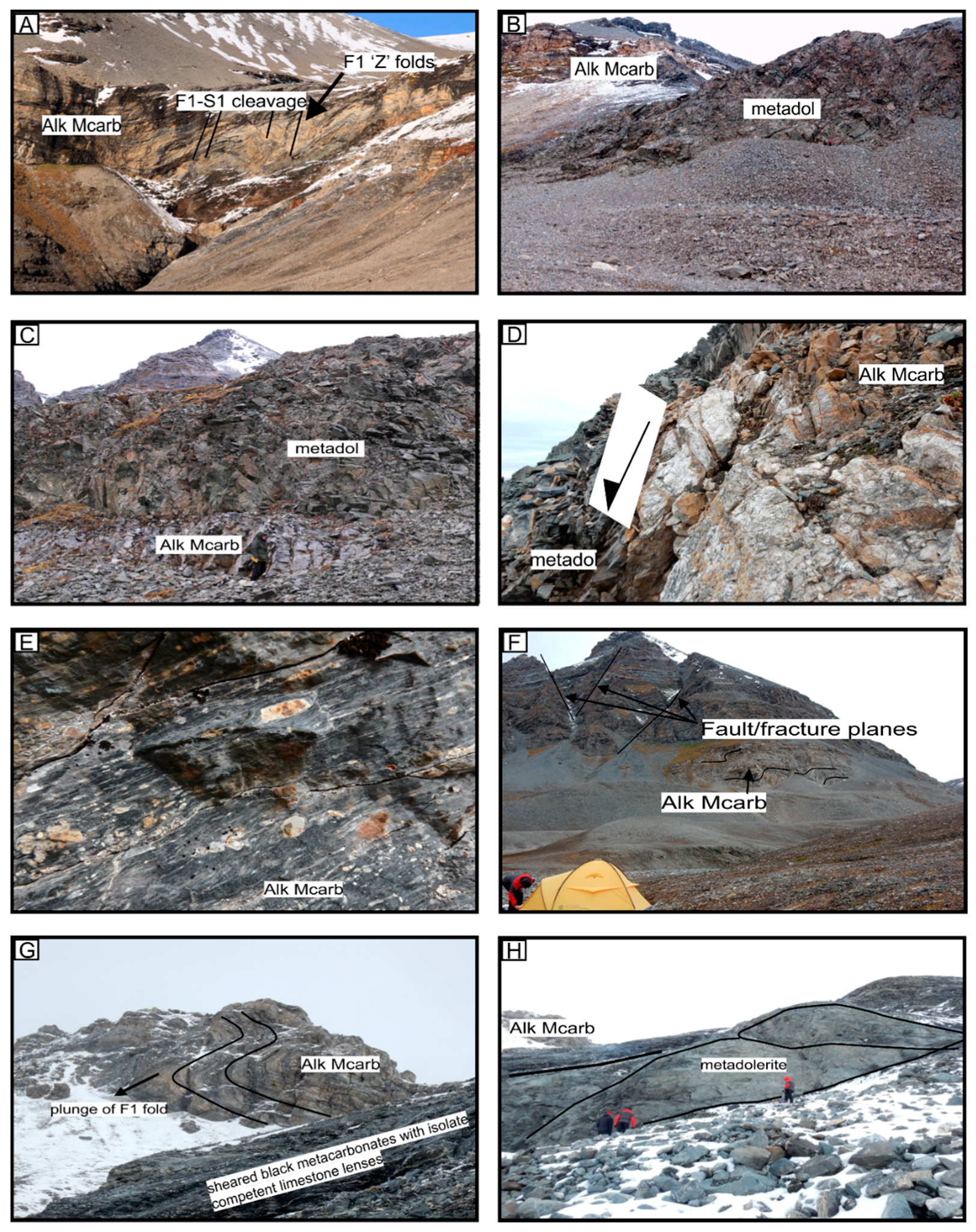
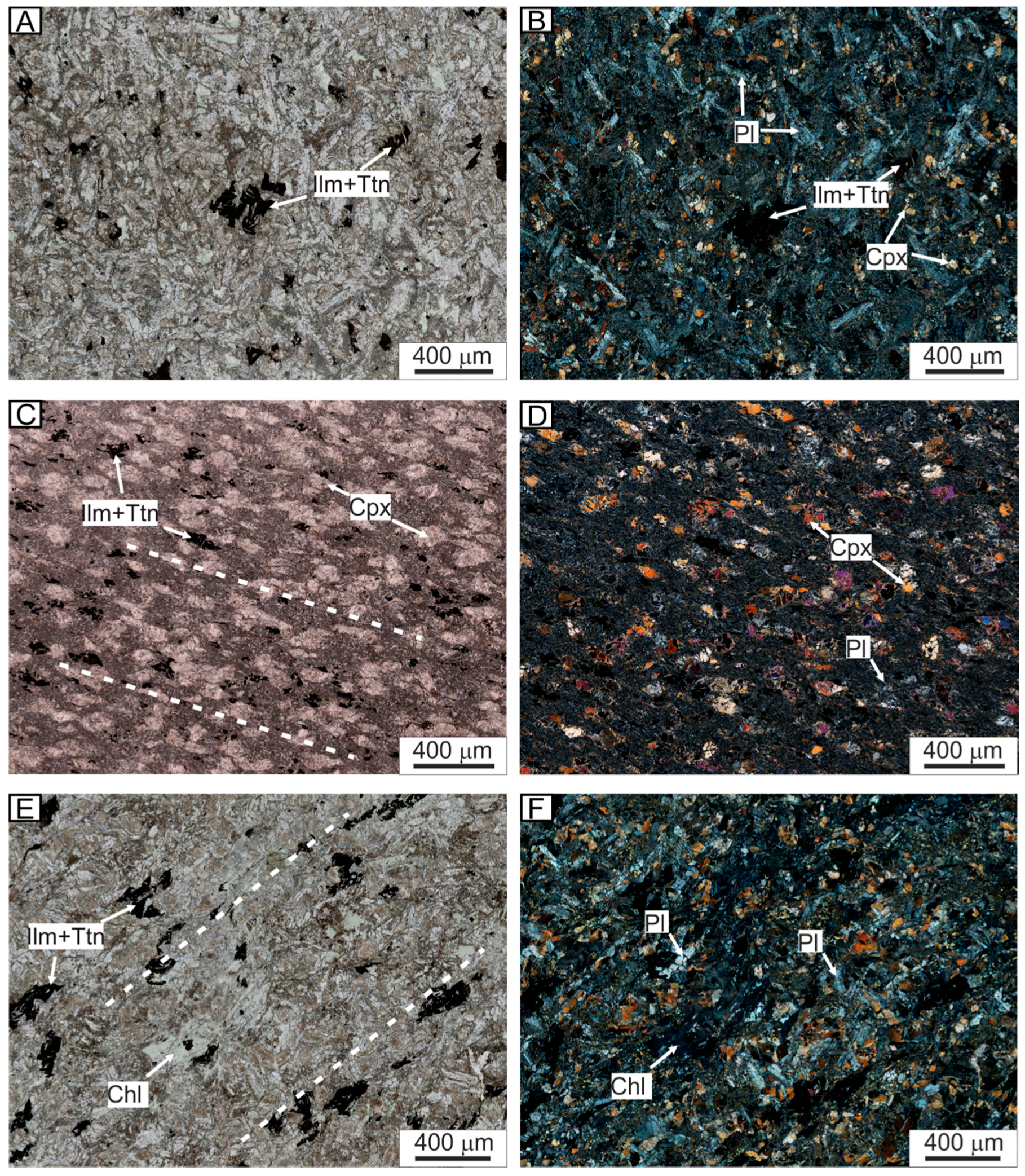

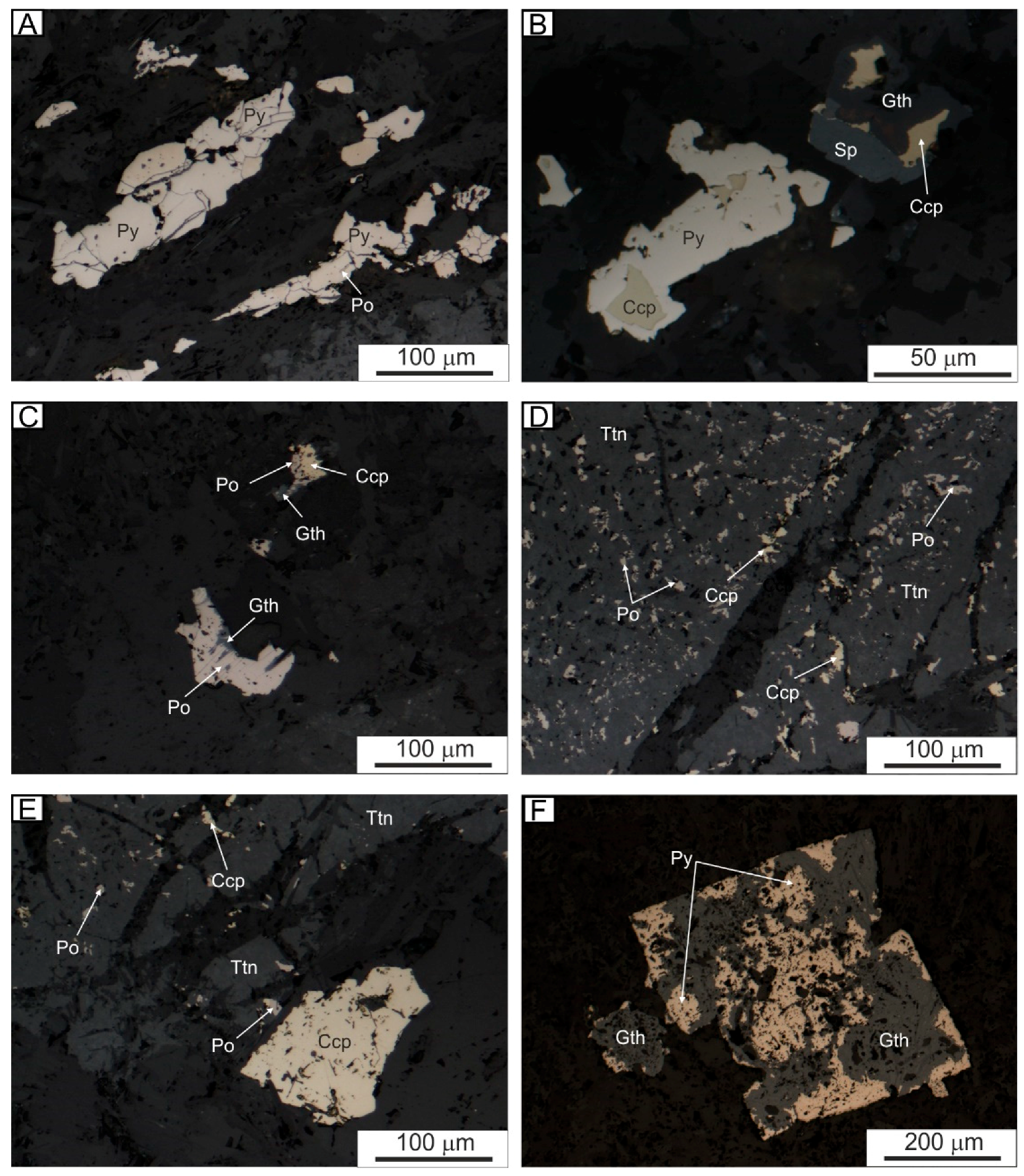
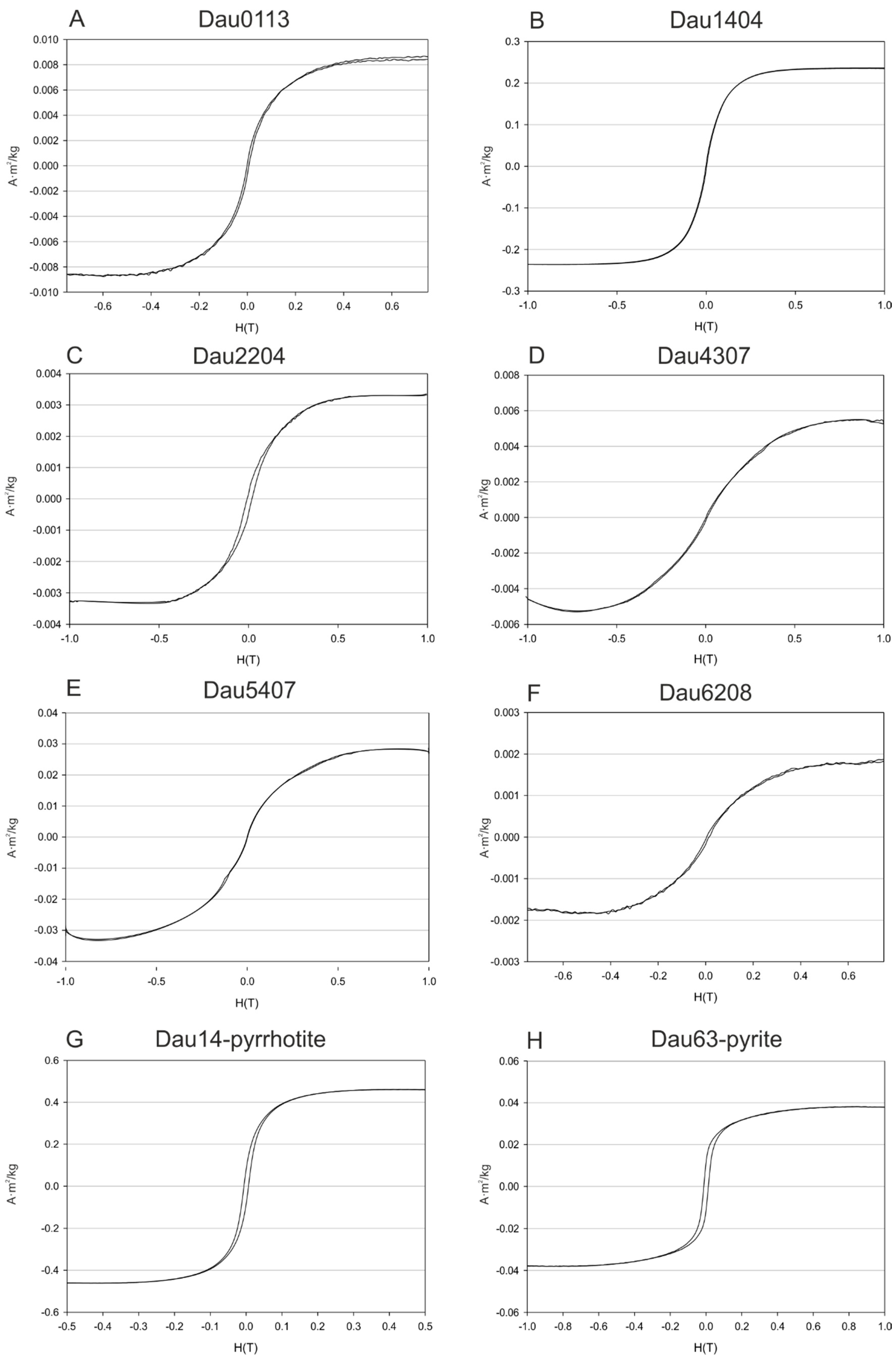
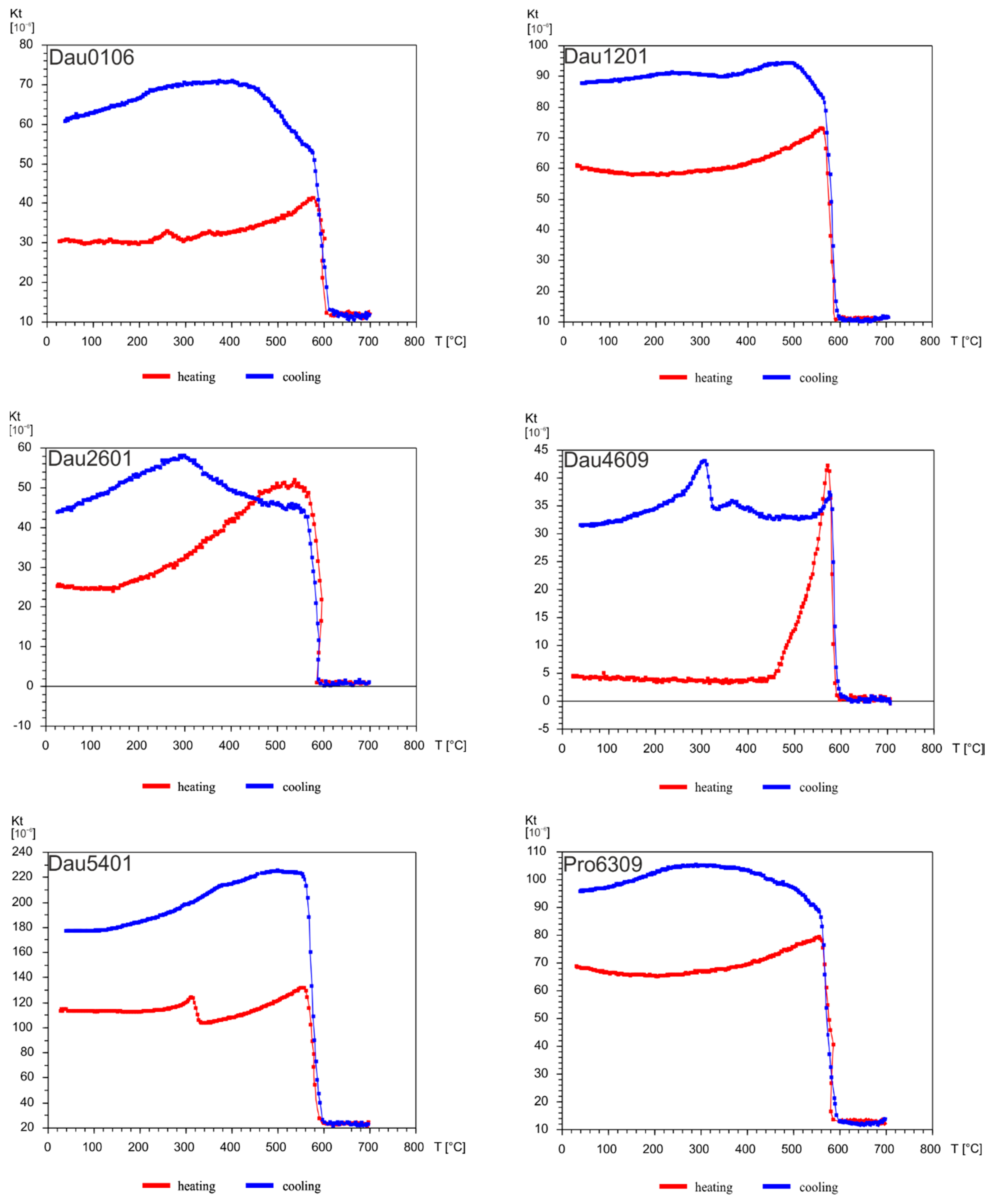
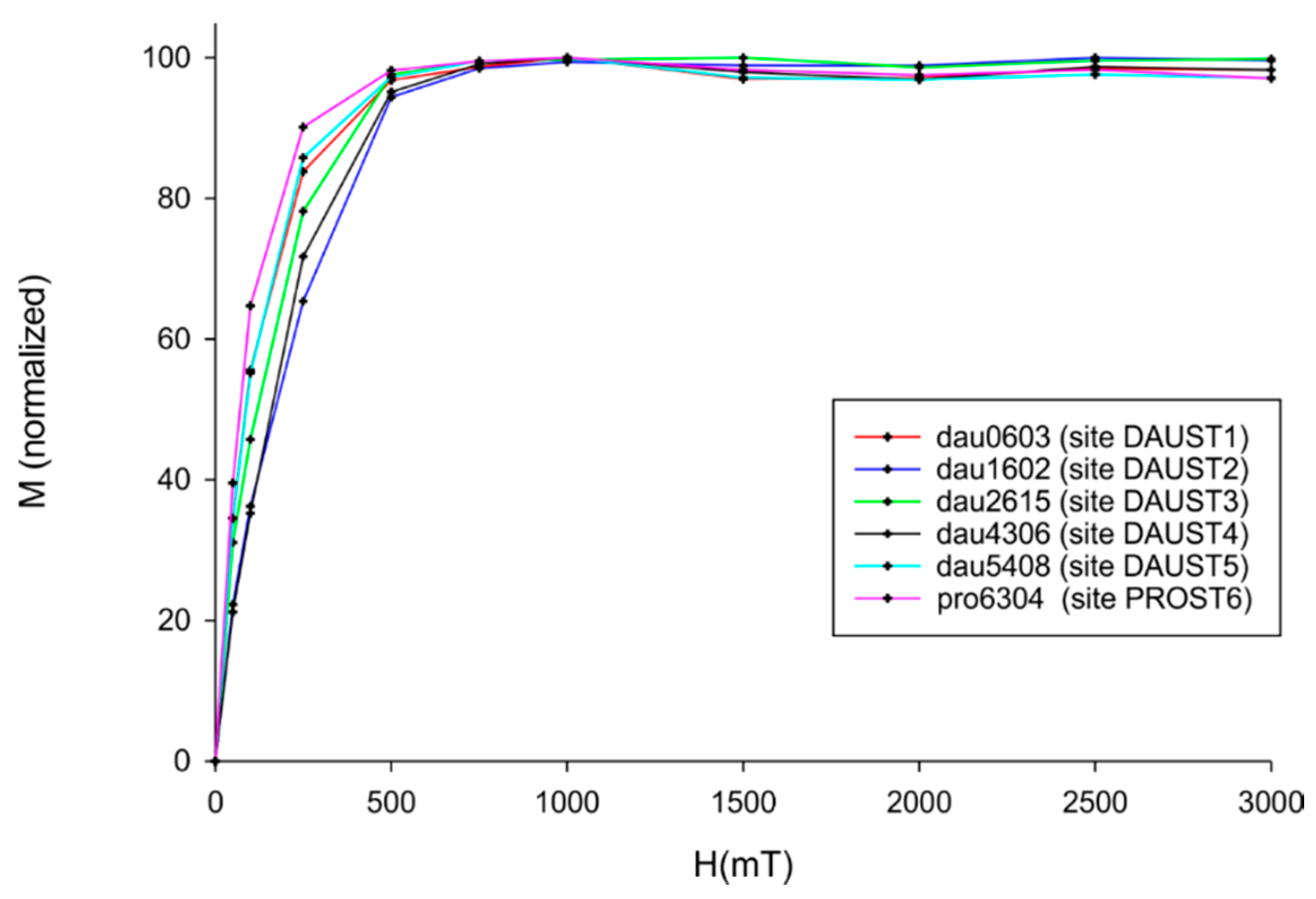
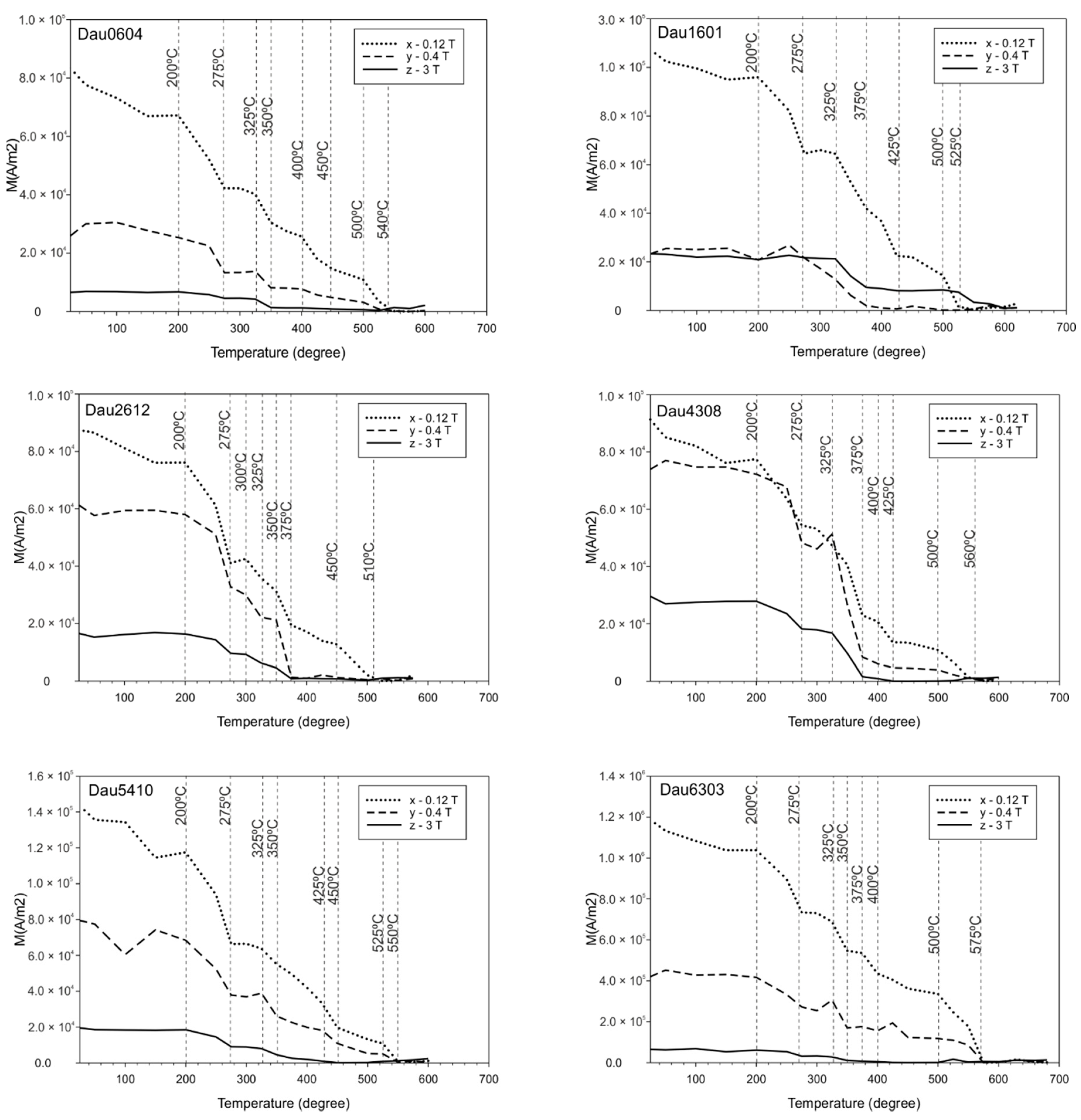
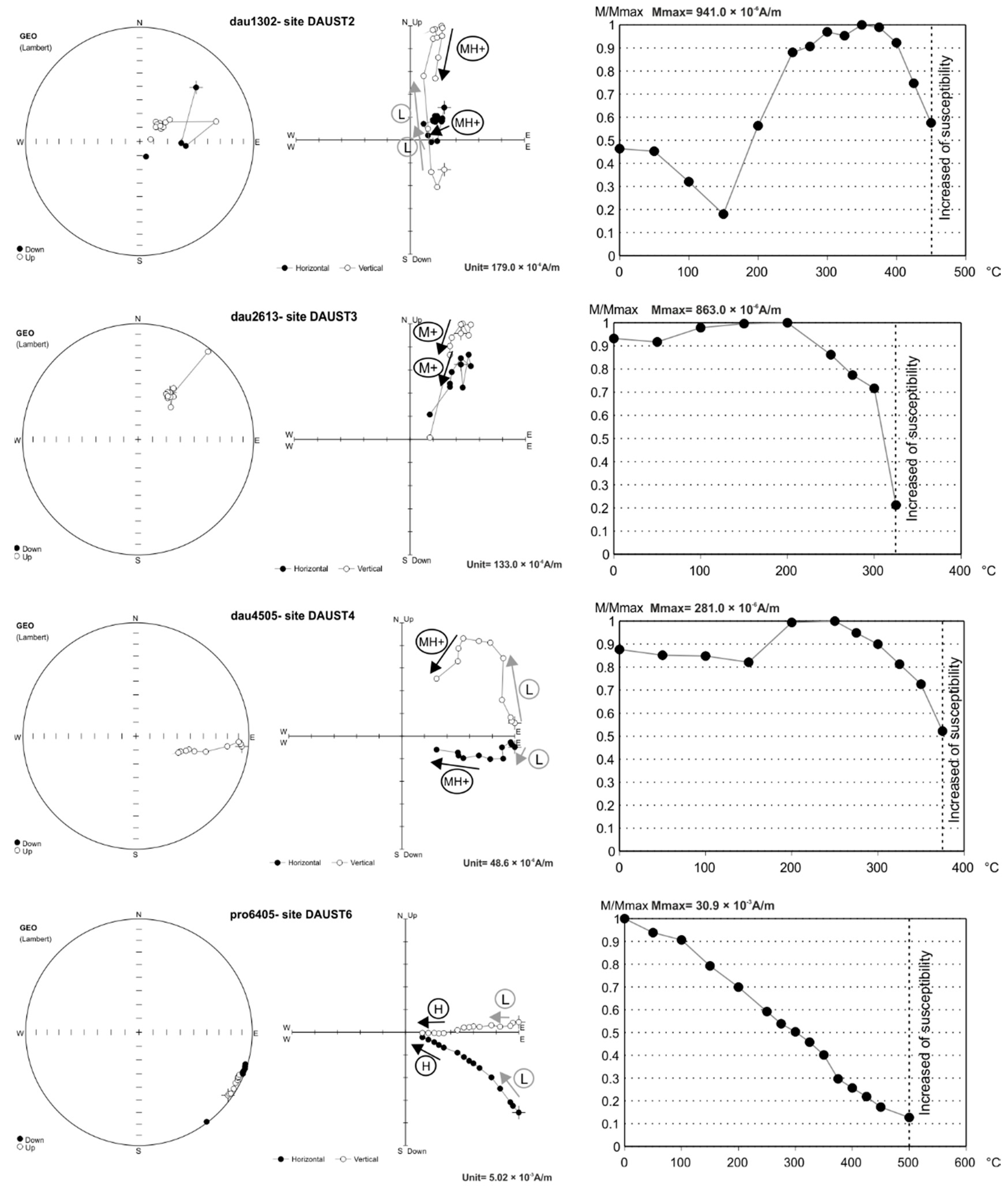
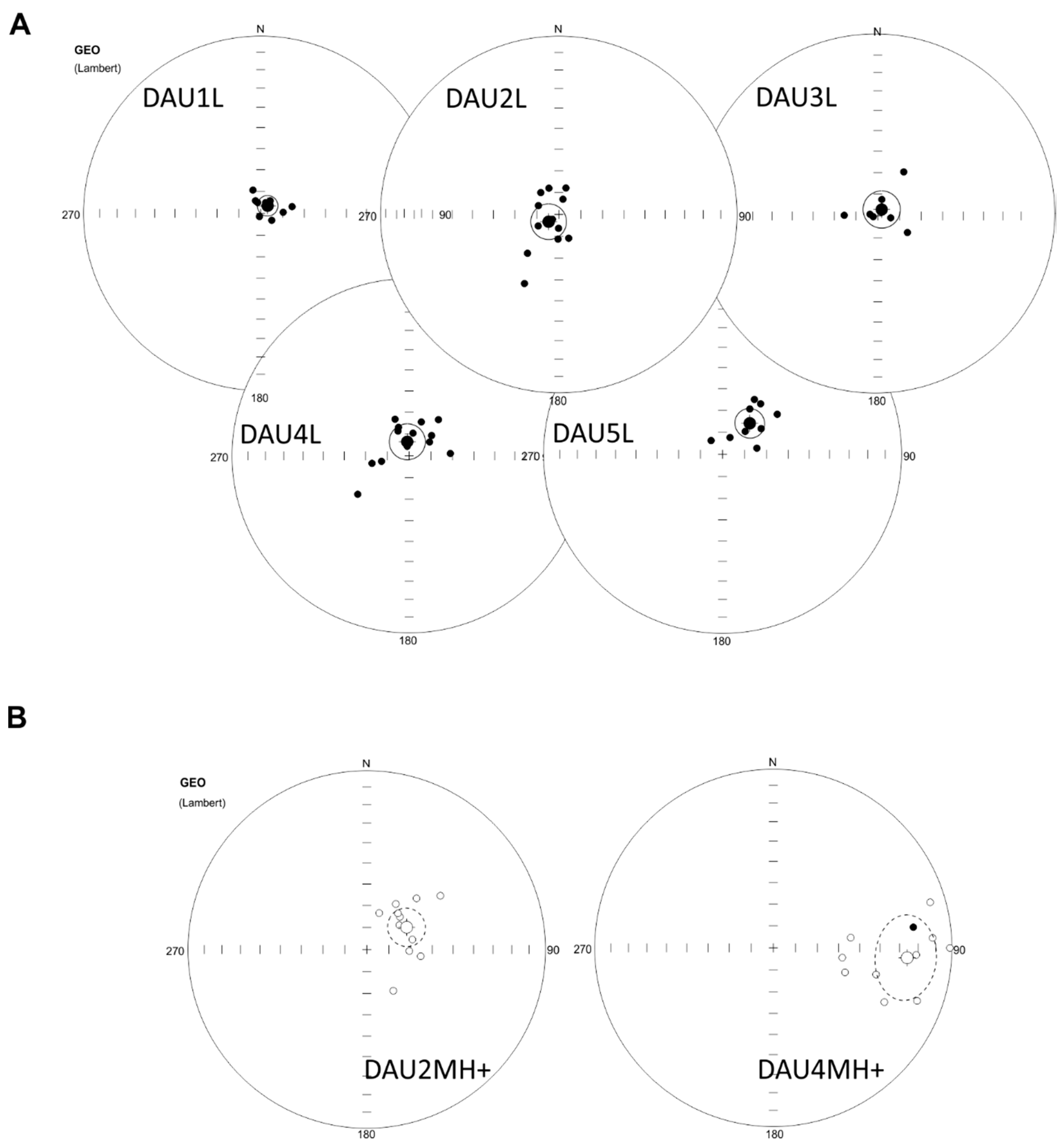


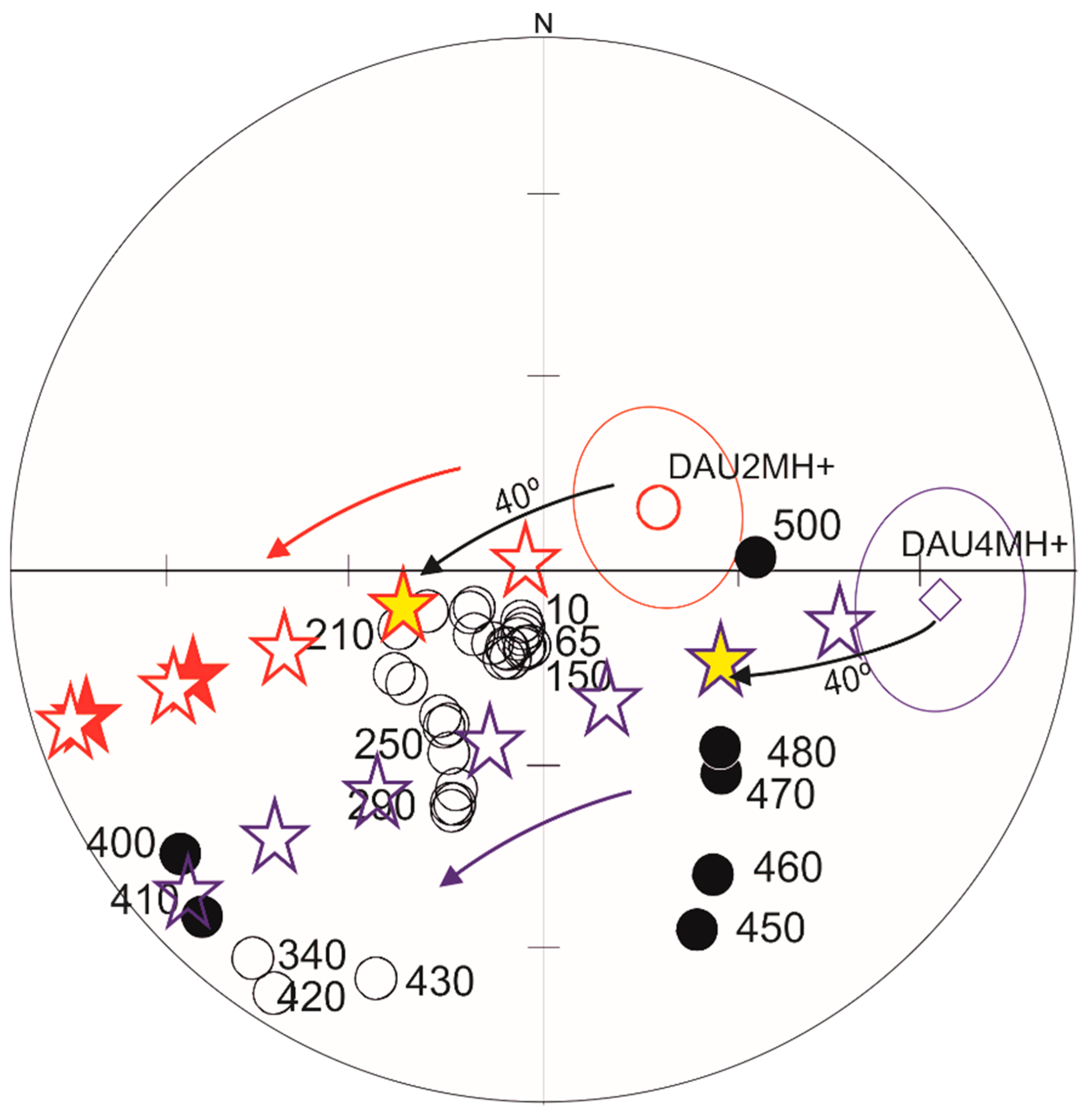
| No. | Samples | Description | Ms (A m2/kg) | Mr (A m2/kg) | Hc (mT) | Hcr (mT) | Mr/Ms | Hcr/Hc |
|---|---|---|---|---|---|---|---|---|
| 1 | Dau0113 | “whole-rock”–metadolerites | 4.09 × 10−3 | 4.55 × 10−4 | 4.02 | 8.34 | 0.11 | 2.07 |
| 2 | Dau1404 | 1.66 × 10−2 | 8.09 × 10−4 | 3.25 | 8.03 | 0.05 | 2.47 | |
| 3 | Dau2204 | 3.39 × 10−3 | 3.47 × 10−4 | 13.39 | 29.48 | 0.10 | 2.20 | |
| 4 | Dau4307 | 5.21 × 10−3 | 4.00 × 10−4 | 3.97 | 9.25 | 0.08 | 2.33 | |
| 5 | Dau5407 | 2.29 × 10−2 | 6.52 × 10−3 | 2.22 | 7.66 | 0.29 | 3.45 | |
| 6 | Pro6208 | 3.33 × 10−3 | 4.45 × 10−4 | 7.81 | 35.50 | 0.13 | 4.55 | |
| 7 | Dau14-63-Po | metadolerite-pyrrhotite 1 | 4.61 × 10−1 | 8.26 × 10−2 | 6.42 | 11.41 | 0.18 | 1.78 |
| 8 | metadolerite-pyrrhotite 2 | 1.46 × 10−1 | 5.23 × 10−2 | 8.41 | 9.79 | 0.36 | 1.16 | |
| 9 | metadolerite-pyrrhotite 3 | 2.99 × 10−2 | 9.94 × 10−3 | 6.66 | 9.57 | 0.33 | 1.44 | |
| 10 | Dau14-63-Py | metadolerite-pyrite 1 | 3.78 × 10−2 | 1.14 × 10−2 | 12.93 | 16.01 | 0.30 | 1.24 |
| 11 | metadolerite-pyrite 2 | 3.86 × 10−1 | 1.43 × 10−1 | 11.10 | 12.90 | 0.37 | 1.16 |
| Site | Site GPS Location | Components | D (°) | I (°) | S/s | N/n | α95 | κ |
|---|---|---|---|---|---|---|---|---|
| DAU1 | N78°12’32.8 E13°40’24.9 | DAU1L | 42.7 | 85.3 | 6/22 | 4/9 | 4.7 | 120.7 |
| DAU2 | N78°12’33.1 E13°40’38.9 | DAU2AFL | 348.4 | 74.5 | 5/5 | 4/4 | 31.0 | 9.73 |
| DAU2L | 234.6 | 84.4 | 6/18 | 5/12 | 8.1 | 29.64 | ||
| DAU2MH+ | 60.9 | −69.2 | 6/18 | 5/11 | 8.6 | 28.84 | ||
| DAU3 | N78°12’33.3 E13°40’48.3 | DAU3L | 310 | 86.5 | 6/18 | 5/8 | 8.5 | 43.21 |
| DAU3M+ | 85.8 | −16.8 | 6/18 | 4/9 | 27.0 | 4.58 | ||
| DAU4 | N78°12’5.7 E13°41’20.9 | DAU4L | 352.6 | 83.5 | 6/18 | 5/13 | 8.2 | 26.25 |
| DAU4MH+ | 94.2 | −25.8 | 6/18 | 5/11 | 16.5 | 8.63 | ||
| DAU5 | N78°11’52.4 E13°40’04.1 | DAU5L | 41.3 | 71.2 | 6/18 | 5/10 | 6.7 | 52.65 |
| DAU5AFL | 30.7 | 81.3 | 6/7 | 4/4 | 84.5 | 2.17 | ||
| DAU5MH+ | 59.2 | −53.2 | 6/18 | 6/12 | 33.2 | 2.67 | ||
| PRO6 | N78°13’56.8 E13°41’42.6 | PRO6L | 108.8 | 29.3 | 6/18 | 4/5 | 40.4 | 4.53 |
| PRO6H | 114.2 | −13.0 | 6/18 | 4/5 | 37.1 | 5.21 |
| VGP Symbol | N | n | P | D (°) | I (°) | α 95 | κ | Φ (°) N | Λ (°) E | Dp/Dm (°) | Plat (°) |
|---|---|---|---|---|---|---|---|---|---|---|---|
| DAU1L | 4 | 9 | N | 42.7 | 85.3 | 4.7 | 120.7 | 81.88 | 64.68 | 9.2/9.3 | 80.7 |
| DAU2L | 5 | 12 | N | 234.6 | 84.4 | 8.1 | 29.64 | 69.50 | 346.89 | 15.8/16.0 | 78.9 |
| DAU2MH+ | 5 | 11 | R | 60.9 | −69.2 | 8.6 | 28.84 | −45.86 | 144.12 | 12.5/14.7 | 52.8 |
| DAU3L | 5 | 8 | N | 310 | 86.5 | 8.5 | 43.21 | 80.80 | 337.92 | 16.8/16.9 | 83.0 |
| DAU4L | 5 | 13 | N | 352.6 | 83.5 | 8.2 | 26.25 | 88.20 | 259.41 | 15.8/16.1 | 77.2 |
| DAU4MH+ | 5 | 11 | R | 94.2 | −25.8 | 16.5 | 8.63 | −14.16 | 102.27 | 9.6/17.8 | 13.6 |
| DAU5L | 5 | 10 | N | 41.3 | 71.2 | 6.7 | 52.65 | 63.69 | 136.55 | 10.2/11.7 | 55.8 |
© 2018 by the authors. Licensee MDPI, Basel, Switzerland. This article is an open access article distributed under the terms and conditions of the Creative Commons Attribution (CC BY) license (http://creativecommons.org/licenses/by/4.0/).
Share and Cite
Burzyński, M.; Michalski, K.; Manby, G.; Nejbert, K. Mineralogical, Rock-Magnetic and Palaeomagnetic Properties of Metadolerites from Central Western Svalbard. Minerals 2018, 8, 279. https://doi.org/10.3390/min8070279
Burzyński M, Michalski K, Manby G, Nejbert K. Mineralogical, Rock-Magnetic and Palaeomagnetic Properties of Metadolerites from Central Western Svalbard. Minerals. 2018; 8(7):279. https://doi.org/10.3390/min8070279
Chicago/Turabian StyleBurzyński, Mariusz, Krzysztof Michalski, Geoffrey Manby, and Krzysztof Nejbert. 2018. "Mineralogical, Rock-Magnetic and Palaeomagnetic Properties of Metadolerites from Central Western Svalbard" Minerals 8, no. 7: 279. https://doi.org/10.3390/min8070279





